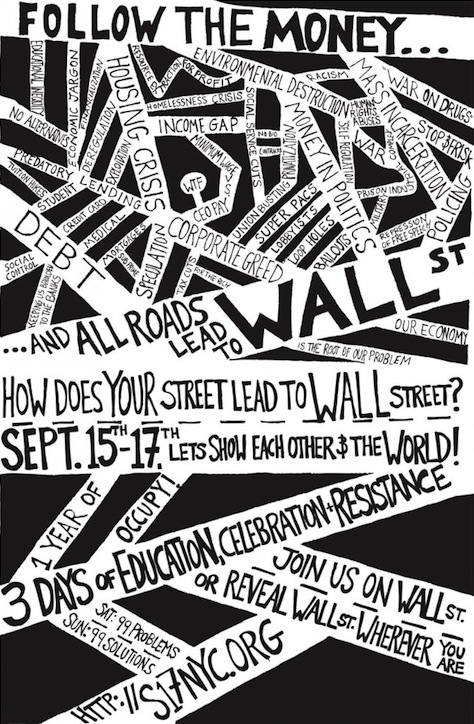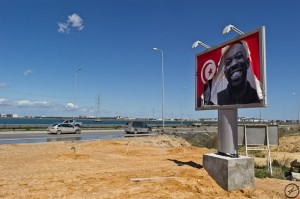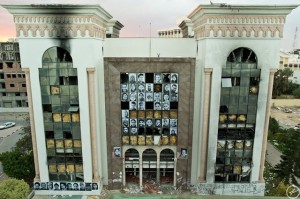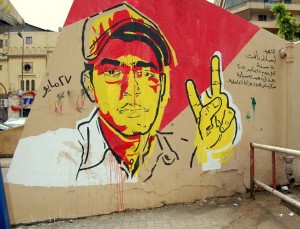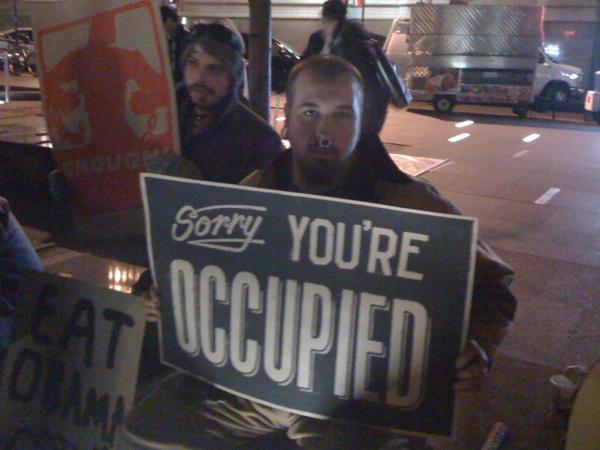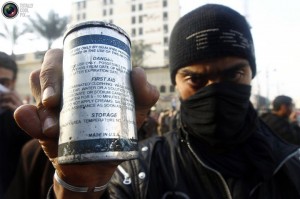Two new journalistic takes on OWS and the September 17 anniversary day of action are causing some waves in the movement. It’s interesting to look at them and see how two journalists can talk to much the same set of people and generate very different interpretations. It raises the question of what a social movement wants from the media, as well as the more discussed question of what it gets.
The pieces in question are in very different publications. In the Village Voice, house journal of the NYC counterculture, Nick Pinto has a long take on “Occupy Wall Street, Year Two.” Many people are greeting this as the best piece on OWS for a long time, which I take to mean closest to how OWS views itself. On the other hand, there’s Max Abelson’s piece for Bloomberg News, entitled “Occupy Sets Wall Street Tie-up as Protestors Face Burn Out.” While Abelson seems not unsympathetic to the movement, look at who he’s writing for: so it’s no surprise that the piece feels more critical. Internally, people have been disappointed because he did spend a long time talking with leading figures.
Let’s walk through the pieces quickly. Pinto begins with the standard observation that the very diversity of OWS opinion makes it hard to create and sustain consensus. However, he then suggests:
The factionalism that for so long seemed to threaten to tear the movement apart seems increasingly manageable. After a year of precisely these sorts of arguments, anarchists, liberals, and union stalwarts all know the contours of their disagreements, but they’re also better than they’ve ever been at pushing through them.
They’re also increasingly confident that whatever this thing is that binds them together, that keeps them coming back to the next meeting, the next hard-won consensus, whatever they call that shared project, it has a future beyond this first anniversary.
That’s what I meant when I said that the piece reflects the internal discourse of OWS. Pinto continues to describe the combination of police violence and the “dominant media narrative” that there’s “nothing to see here.”
Acknowledging that, for many occupiers, it’s how things get done as much as what the immediate results are that matters, Pinto talks about the projects like Strike Debt, Occupy Homes, and Foreclose the Banks that get activists excited and have emerged or grown significantly since May 1. Perhaps it’s in part because Pinto quotes a lot of people that I happen to know or have met but this piece does convey my own sense of OWS right now. The acknowledgement that May Day was not a complete success. The recognition that there won’t be another occupation. The determination to continue.
It’s that last that Max Abelson doesn’t see. The emphasis for him is on dysfunction and burnout:
Organizers said there has been more fatigue than fresh thinking this year. Occupy’s New York City General Assembly, which oversaw planning by consensus, ceased functioning in April because of infighting, ineffectiveness and low turnout, according to organizers and minutes of meetings. The group’s funds were frozen to preserve money for bail, ending most cash distributions, they said.
While the unnamed organizers are correct, for most of us April is an age ago. It’s hard to find people who still regret the passing of the GA, although there are occasional calls for a central decision making body. As the piece continues, the emphasis remains on “burnout,” “calcification,” “ossify”–a movement past its prime.
The Abelson piece reads as if it has been edited hard from a longer essay, as quotes float in and out without discussion or context. Subheads like “Venemous Forums” or “Anarchist Core” catch the eye but aren’t the writer’s fault. He does place a lot of emphasis on what I can only think was a throw-away comment about making citizens’ arrests on September 17, which runs counter to most people’s sense of what OWS is about.
In the end, then, what we have is a nice snapshot in a friendly media outlet and a not terrible but not great, slightly sensationalist piece in a very hostile outlet. Why is that no good? Why do we so often want to have a “celebrity” endorse a cause or an action, just like every other media-directed project? In part I’m thinking back to a job search we did last year in my department for someone working on media activism. The overwhelming impression I was left with was how hard such activism is in the face of the corporate behemoths. Now that even the New York Times has taken to calling Republican media statements “lies,” perhaps the gap is closing.
If Occupy is trying to build a new world in the shell of the old, what would its media look like? Projects like Tidal: Occupy Theory, Occupy Strategy, whose third issue is just out; or Occupy! the OWS-Inspired Gazette (new edition due September 15) are trying to do that work. It’s very hard: questions of funding, printing and distribution have to be solved by the same people doing the editing, writing and commissioning.
These publications are not, as some might say, preaching to the converted. They are given away free, often to the curious people standing on the edge of a meeting or a rally who wants to know more but isn’t ready to get involved. In a city of 19 million people, working like this takes time. That’s OK. At certain moments, like last September 17, new possibilities emerge. What we’ve all been doing ever since is to try and keep that possibility open for as long as we can.

